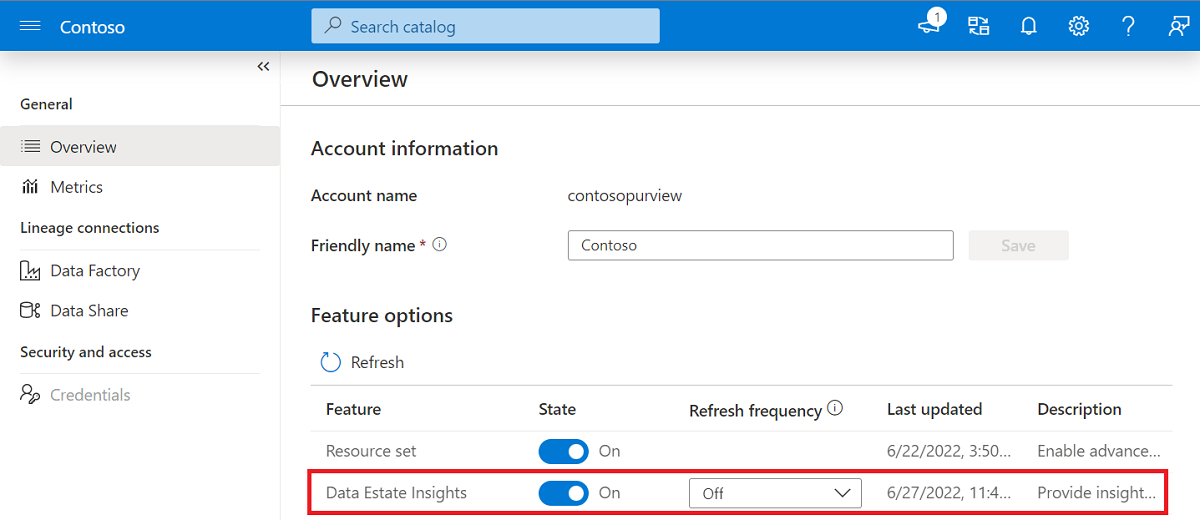Pricing for Data Estate Insights
This guide covers pricing guidelines for Data Estate Insights.
For a full pricing guideline details for Microsoft Purview (formerly Azure Purview), see the pricing guideline overview.
For specific price details, see the Microsoft Purview (formerly Azure Purview) pricing page. This article will guide you through the features and factors that will affect pricing for Data Estate Insights.
Guidelines
Data Estate Insights is billed on two dimensions:
Report generation - this incorporates the job that checks for any changes in your environment and the jobs that aggregate metrics about your Microsoft Purview account that will appear in specific reports.
- If you have set your reports to refresh on a schedule, at the time of refresh there will be a job to check if any updates have been made to your environment. You'll always be billed a small amount for this check.
- If updates have been made to your environment, you'll be billed for the jobs that aggregate metrics and generate your report.
Note
On the pricing page, you can find details for report generation pricing under Data Map Enrichment.

Report consumption - This incorporates access of the report features (currently served through the UX). On the pricing page, you can find details for report generation pricing under Data Estate Insights.

Important
The Data Estate Insights application is on by default when you create a Microsoft Purview account. This means, “State” is on and “Refresh Frequency” is set to automatic*.
* At this time automatic refresh is weekly.
If you want to reschedule or reduce how often your reports are refreshed, you can schedule your Data Estate Insights reports.
If you don't plan on using Data Estate Insights for a while, a data curator on the root collection can disable Data Estate Insights features in one of two ways:
- Disable the Data Estate Insights application - this will stop billing from both report generation and report consumption.
- Disable report refresh - insights readers have access to current reports, but reports won't be refreshed. Billing will occur for report consumption but not report generation.
Note
The application or report refresh can be enabled again later at any time.
A data curator on your account's root collection can make these changes in the Management section of the Microsoft Purview governance portal in Overview, under Feature options. For specific steps, see the disable Data Estates Insights article

Schedule Report Refresh
Your reports can be scheduled to refresh daily, weekly, or monthly depending on your needs, and this will affect billing.
Firstly, on the date/time of your scheduled refresh, insights will run a job to check if any changes have been made in your environment since the last refresh. You'll always be billed for this job.
If changes have been made since the last report refresh, billing is calculated based on the amount of compute power that is used to generate the report, and is billed at the time of report generation. For more information about specific pricing, see the pricing page under Data Map Enrichment.
For more information about setting your refresh schedule, see the schedule Data Estate Insights reports article.
Disable the Data Estate Insights application
Disabling Data Estate Insights will disable the entire application, including these reports:
- Stewardship
- Asset
- Glossary
- Classification
- Labeling
The application icon will still show in the menu, but insights readers won't have access to reports at all, and report generation jobs will be stopped. The Microsoft Purview account won't receive any bill for Data Estate Insights.
For steps to disable the Data Estate Insights application, see the disable article.
Disable report refresh
You can choose to disable report refreshes instead of disabling the entire Data Estate Insights application.
When you disable report refreshes, insight readers will be able view reports but they'll see a banner on top of each report, warning that the report may not be current. It will also indicate the date the report was last generated.
In this case, graphs showing data from last 30 days will appear blank after 30 days. Graphs showing snapshot of the data map will continue to show graph and details. When an insights readers accesses an insight report, report consumption meter will be triggered, and the Microsoft Purview account will be billed.
For steps to disable report refresh see the disable article.
Next steps
Feedback
Coming soon: Throughout 2024 we will be phasing out GitHub Issues as the feedback mechanism for content and replacing it with a new feedback system. For more information see: https://aka.ms/ContentUserFeedback.
Submit and view feedback for